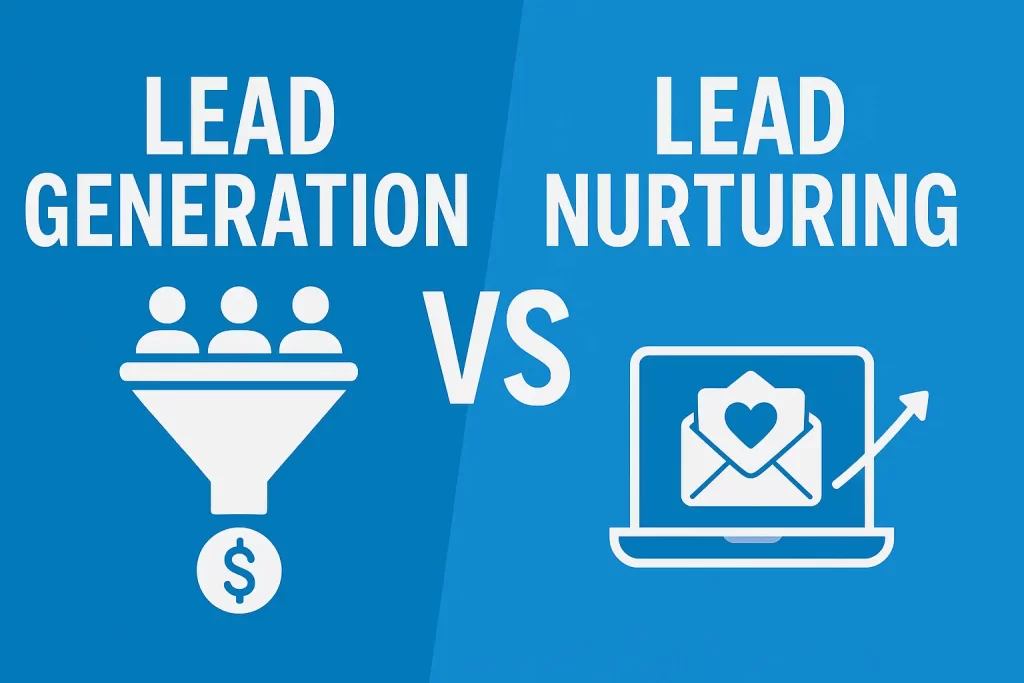🔍 Introduction: Why This Difference Matters
In today’s competitive digital marketing world, businesses are not just looking for more leads — they are looking for qualified and converting leads.
However, many marketers still confuse Lead Generation with Lead Nurturing, using both terms interchangeably.
While both are essential parts of the sales funnel, they serve completely different purposes.
Understanding this difference can help you build a marketing strategy that doesn’t just attract leads — but also converts them into long-term, loyal customers.
In this blog, you’ll learn:
✅ What is Lead Generation?
✅ What is Lead Nurturing?
✅ The key differences between the two
✅ How both work together in digital marketing
✅ Best practices for 2025 SEO & conversion success
🚀 What is Lead Generation?
Lead Generation is the process of attracting and capturing potential customers (leads) who have shown interest in your product or service.
It is the first step of the customer journey, focused on creating awareness and interest.
🔸 Purpose:
To bring new people into your marketing funnel by collecting their contact information — name, email, phone, etc.
🔸 Common Lead Generation Strategies:
- Running Facebook & Instagram Lead Ads
- Offering a Free eBook, Checklist, or Webinar
- Using Google Search Ads for high-intent keywords
- Creating SEO-optimized landing pages
- Running YouTube or LinkedIn campaigns
- Website pop-ups offering discounts or guides
🔸 Example:
A digital marketing trainer offers a free “Google Ads Mastery eBook.”
Visitors fill in their details to download it — that’s lead generation.
🌱 What is Lead Nurturing?
Once a lead has shown interest, the real work begins.
Lead Nurturing is the process of building relationships, educating, and guiding those leads until they are ready to buy.
This stage focuses on trust, value, and engagement.
🔸 Purpose:
To move leads from interest → consideration → decision, using continuous communication and personalized content.
🔸 Common Lead Nurturing Strategies:
- Sending automated email sequences with value-driven content
- Running retargeting ads to re-engage website visitors
- Sharing case studies, testimonials, and success stories
- Hosting live sessions or workshops
- Sending WhatsApp or SMS reminders
- Using a CRM tool (like HubSpot, Zoho, or Salesforce) for follow-ups
🔸 Example:
After downloading your eBook, the lead receives a series of emails — a tutorial, a case study, and an invitation to a paid course.
When the lead finally registers — that’s lead nurturing success.
🧠 Lead Generation vs Lead Nurturing: Key Differences
| Factor | Lead Generation | Lead Nurturing |
|---|---|---|
| Goal | Attract new leads | Build trust & convert leads |
| Focus | Awareness & Interest | Education & Relationship |
| Funnel Stage | Top of the Funnel (TOFU) | Middle & Bottom (MOFU & BOFU) |
| Tactics | Ads, SEO, Free Resources | Email Sequences, Retargeting, Personalization |
| Duration | Short-term | Long-term |
| Tools | Meta Ads, Google Ads, Landing Pages | Email Tools, CRM, Automation Tools |
| Metric | Number of leads captured | Conversion rate or sales growth |
🔄 How Both Work Together
Think of your marketing process like a relationship journey:
- Lead Generation = The first meeting. You attract their attention.
- Lead Nurturing = The dating phase. You build trust, show value, and deepen the connection.
- Sales Conversion = The commitment. The lead finally decides to buy.
Without nurturing, your leads will lose interest.
Without generation, you won’t have anyone to nurture.
👉 Both are equally important for a healthy and profitable marketing ecosystem.
💡 Best Practices for 2025: Lead Generation & Nurturing
To align with the latest Google SEO Algorithms (2025) and marketing trends, follow these strategies:
1. Focus on E-E-A-T (Experience, Expertise, Authoritativeness, Trustworthiness)
Google ranks websites higher when they demonstrate real-world expertise and trust signals.
✅ Use author bios, testimonials, case studies, and clear credentials.
2. Optimize for Search Intent
Target keywords based on what your audience is actually searching for.
Example keywords:
- “Lead generation vs lead nurturing”
- “Lead nurturing strategies 2025”
- “How to generate leads online”
3. Create Helpful, Long-Form Content
Google prefers in-depth articles (1500+ words) that genuinely educate readers.
4. Use Smart CTAs
Add relevant call-to-actions like:
- “Download our Free Lead Nurturing Checklist”
- “Join Our Free Digital Marketing Workshop”
5. Leverage Automation Tools
Automate your email & retargeting sequences using tools like:
🧩 Real-Life Example
A digital marketing trainer runs a Facebook ad offering a free 2-hour online class on “Meta Ads for Business Growth.”
- 500 business owners register (Lead Generation)
- The trainer then sends weekly tips, case studies, and invites them to a paid mentorship (Lead Nurturing)
Result: 50 paid conversions and long-term brand trust.
That’s the power of combining both strategies.
🧭 Conclusion
Both Lead Generation and Lead Nurturing are pillars of a successful digital marketing ecosystem.
- Lead Generation brings in quantity
- Lead Nurturing ensures quality and conversion
In short:
Lead Generation gets attention.
Lead Nurturing earns trust.
Together, they drive sales.
🚀 Want to learn how to build a lead system that attracts and converts automatically?
Join Shailesh Panchal’s Digital Marketing Mentorship Program and master Lead Generation, Lead Nurturing, and Conversion Optimization using real-world strategies.

